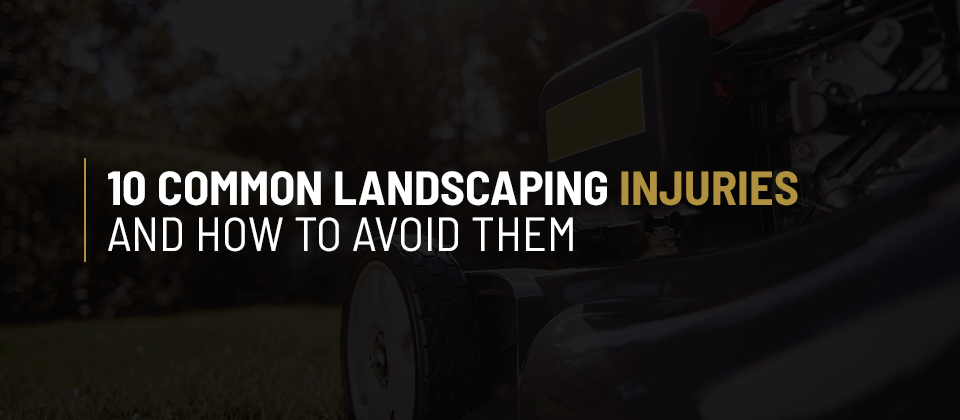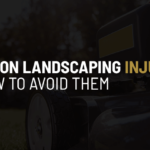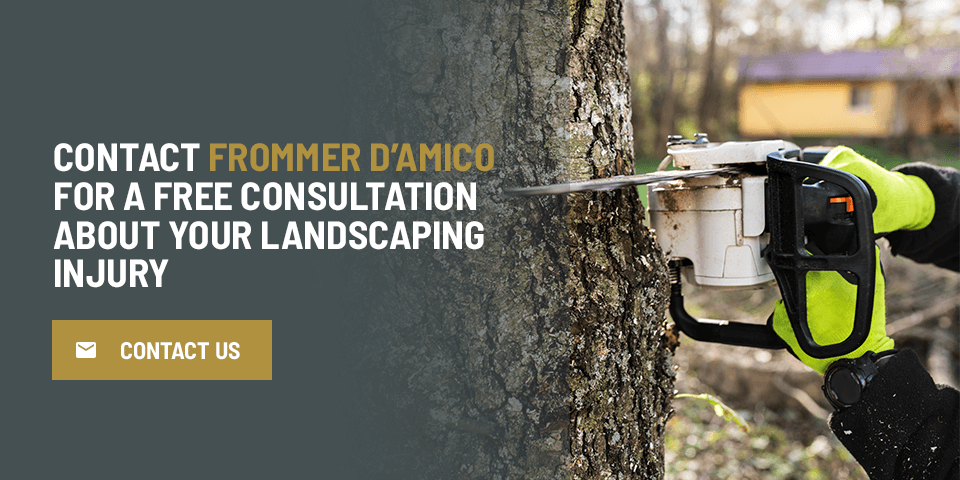
10 Common Landscaping Injuries and How to Avoid Them
Those in the landscaping industry encounter a range of hazards every day while on the job. The occupation’s injury rate is higher than other industries, making it crucial for employees to understand OSHA landscaping safety regulations. In 2019, nearly 12,400 landscaping workers had injuries that resulted in time away from work.
If you’re in the landscaping industry, it’s essential to understand the most common landscaping hazards to prevent workplace injuries.
1. Falls and Slips
One of the most common workplace injuries is falling — and landscapers are just as prone to falls as other workers.
A fall can either be elevated or on the same level. An elevated fall happens when a worker falls from a surface higher than ground level, such as out of a tree, off a ladder or into a hole. While elevated falls are less typical, they’re usually much more severe than same-level falls. A landscaper may experience a same-level fall when they slip on a slick surface or trip. Typically, a trip happens when a worker’s foot strikes an unexpected object in their path or they step onto a lower surface than expected.
After a fall, workers could sustain injuries including broken and fractured bones, sprains and bruises. It’s critical to prevent fall injuries by taking the following precautions:
- Plan for the job: Before starting a job, you should consider the required tools and tasks. OSHA regulations require that you wear a fall protection device when working at heights 4 feet or higher or over dangerous equipment.
- Properly use equipment: Ensure you understand how to use all equipment before using it. Check that ladders are ANSI-certified and crack-free and have tight rungs. Keep ladders clean and dry and ensure you’re wearing high-traction, heeled shoes. When a ladder rests along a wall, your waist should only go as high as the top rung.
- Wear the proper footwear: Be sure to wear shoes with enough traction to prevent falls. Proper shoes have a higher coefficient of friction (COF) between the shoe and the walking surface. For example, non-slip-resistant shoes, like leather soles on a wet or smooth surface, may have a COF of 0.10. Alternatively, higher-traction footwear, such as rubber soles, have a COF of 0.40 to 0.50.
If you lost consciousness at any time during a fall, have pain or are experiencing nausea, headaches or dizziness, you should visit a doctor immediately.
2. Cuts and Bruises From Equipment
These injuries typically happen when workers come into contact with equipment, such as getting hit when digging, sawing, trimming vegetation or mowing. If you’ve been cut by equipment, you must seek proper medical care. The landscaping equipment you’re using is dirty, increasing the risk of untreated cuts becoming infected.
If you experience the following, your wound may be infected:
- Swelling
- Redness
- A fever or the cut feels hotter than surrounding areas
- Pus
- More severe symptoms, like a fever over 100 degrees Fahrenheit, body aches or gastrointestinal problems
Prevent cuts and bruises from equipment by thoroughly reading equipment manuals before use. Understanding best practices for handling equipment can help you avoid landscaping injuries. Make sure to wear protective clothing, carry sharp tools with the blade facing down, keep cutting tools sharp and inspect equipment before use. When using power tools, wait for moving parts to stop by themselves and only use the machine at operating speed.
If you or a co-worker has been cut by equipment, directly apply pressure to the wounds with clean hands and medical gloves. Alternatives to medical gloves include layers of clean cloth, a plastic bag or the cleanest material available. Monitor a cut victim for signs of shock such as losing consciousness or dizziness while waiting for medical care.
3. Electrical Burns
These are the most common injury when dealing with electrical shock incidents. A low-voltage shock is less than 500 volts and may result in burns. Any shocks higher than 500 volts are considered high-voltage and may cause significant harm, such as tissue damage. Sometimes, electrical shocks damage internal tissue, which may be worse than apparent at the skin level.
The variables that determine the severity of a shock include:
- Whether the current is AC or DC
- The source voltage and tissue resistance
- How electricity moves through the body
Prevent electrical burns by surveying an area before working and becoming familiar with OSHA equipment use regulations. After a burn, promptly apply a sterile gauze bandage or use a clean cloth. Never use a blanket or towel, as the fibers might stick to burns. If your burns increase in redness and pain or you’re having confusion, difficulty breathing, muscle pain, heart problems or seizures, seek immediate medical attention.
4. Chemical Burns
In landscaping, toxic chemicals like fertilizers, herbicides and pesticides are a prominent hazard. Exposure to toxic chemicals can burn landscapers’ skin, damage internal organs and potentially cause long-term illnesses such as cancer. A few common symptoms of chemical exposure include nausea, vomiting, fatigue and headaches.
Avoid chemical burns by reading the label and SDS before use, so you understand proper mixing, protective equipment, instructions for applications and first aid instructions. Additionally, wear personal protective equipment (PPE) when dealing with dangerous chemicals. Put on chemical-resistant gloves, long pants and a long-sleeved shirt, making sure to change clothes before leaving the job site.
If you or a co-worker are exposed to landscaping chemicals, immediately flush the contact site with water and remove contaminated clothing. Promptly contact the National Poison Center to determine your next steps. Because the symptoms of pesticide poisoning can surface as late as 24 hours after exposure, you should monitor yourself and others after coming in contact with chemicals.
5. Hearing Damage
Those who are regularly exposed to loud, consistent noise from equipment may lose their hearing due to inner ear damage. Under OSHA noise exposure regulations, employees may be at risk when exposed to noise at or about 85 decibels averaged over 8 hours. However, noise as loud as 95 decibels can damage hearing in less than an hour.
If you consistently work in areas with high noise levels, such as when operating lawnmowers, weedwhackers and other equipment, you may experience irreparable hearing loss or permanent ringing in your ears when you don’t wear proper gear. Beyond harming your hearing, loud noise can also lead to heightened stress and increase landscaping injuries due to the inability to hear warnings.
To preserve your hearing in noisy environments, ensure you have the proper PPE — employers assume much of the responsibility when protecting workers’ hearing. Therefore, aside from supplying PPE, they should also implement a hearing conservation program to preserve landscaping crews’ hearing.
As part of a hearing conservation program, employers should:
- Monitor job site noise levels and inform workers of potential risks
- Provide hearing protection equipment
- Offer free annual hearing exams for workers regularly exposed to high-risk environments
- Schedule crews to limit the amount of time a particular employee is around loud noise
6. Temperature Stress
Extreme heat or cold is also a landscaping hazard.
Hyperthermia, or heat stress, refers to a rapid rise in body temperature. Hot temperatures coupled with high humidity make workers especially vulnerable to overheating, as sweat evaporates slower. Those older than 65 or who have medical problems like obesity, asthma, heart disease or diabetes are at a higher risk of heat-related injuries.
The symptoms of heat stress include:
- Profuse sweating
- Heat rash
- Dizziness
- Nausea
- Heat exhaustion
- Heatstroke
- Rhabdomyolysis, or the death of muscle tissue leading to irregular heart rhythms, potential kidney damage or seizures
Take regular breaks for rest, shade and water to prevent heat-related illness. Be sure to acclimate to the heat by gradually increasing and modifying workloads. If heat-related symptoms continue, seek medical care.
In extreme cold, skin temperature decreases before the core body temperature. Those dealing with the cold have to be aware of factors like wind chill, as a 40-degree Fahrenheit air temperature with a 35 mile-per-hour wind speed will feel like the temperature is 28 degrees Fahrenheit. Continuous exposure to cold weather can lead to hypothermia and frostbite.
Common hypothermia symptoms include:
- Shivering
- Poor coordination
- Drowsiness
- A weak pulse
- Loss of consciousness
To prevent cold-related landscaping injuries, you should eat enough food and drink enough water, take breaks in warm spaces and keep your clothes dry.
7. Electrocution
This injury happens when workers dig near electrical wires or come into contact with overhead power lines while trimming trees. It’s also possible to receive an electrical shock when you’re standing in water, when you’re profusely sweating or when the job site has high humidity. Beyond enduring injuries from the electric shock, workers can also suffer injuries from a fall during an incident with overhead power lines.
Other than death from electrocution, the following health problems can occur after contact with electricity:
- Heart problems like fibrillation or a heart attack
- Eye injuries and cuts from metal fragments
- Injured blood vessels, nerves and muscles
- Rapid throat and lung swelling
To avoid electrocution, always assume aerial cables are at fatal voltage levels, even when they’re isolated or seldom used. Only use extension cords with the third plug, or ground, intact.
After someone is electrocuted, immediately seek medical attention. Never try to move the person, as you could also get electrocuted. When high-voltage lines fall on wet surfaces, currents can quickly spread across the ground, so always keep that in mind.
Someone on-site should also contact the local power company to shut off the power temporarily. If the company can’t turn off the power, you can try to move the source away from you or an injured coworker using nonconductive cardboard, wood or plastic.
8. Lung Damage
Landscapers are exposed to pesticides, fertilizers and herbicides that cause lung damage. Workers also deal with natural particulates found in the Earth’s crust. Silica is a mineral that landscapers are regularly exposed to, as it’s located in soil, rock, sand and concrete. Disturbing silica-rich materials by drilling, hauling or dumping releases microscopic particles that cause diseases like cancer.
Silicosis, a potentially fatal disease similar to asbestosis, happens when the particles scar the lung tissue and decrease lung capacity. Typically, it happens after repeated exposure over many years. People with silicosis experience shortness of breath and a slowly developing cough. More severe lung scarring includes bronchitis-like symptoms, fatigue, fever and leg swelling.
OSHA landscaping safety regulations require employers to monitor silica levels in the air and provide crews with appropriate respirators. Masks with N95 NIOSH certified respirators, particulate filters or cartridges are best to prevent lung damage from particulates, pesticides or fertilizers. Make sure to read labels on any products you use to determine which type of respirator you may need.
Some employees may not be able to wear masks due to medical conditions like asthma or susceptibility to heat exhaustion. Therefore, you must have a doctor conduct a physical examination to certify you are medically fit to wear a mask. If a doctor deems you should not wear a respirator, you should do tasks that are free from respiratory hazards.
If you or an employee have inhaled a pesticide, immediately bring them to fresh air and loosen their clothing. If they aren’t breathing, begin CPR and call 911.
9. Lifting and Straining
Landscapers can experience lifting injuries from the overexertion of carrying a load that’s too heavy, lifting from an awkward position or hauling unstable loads like an overloaded wheelbarrow. Other heavy objects landscapers regularly lift include trees and vegetation, cement blocks and bags of fertilizer. Overexertion injuries like a sore neck, slipped disc or pulled ligaments also happen during repetitive twisting, bending or reaching.
You can prevent lifting injuries by learning how to lift heavy loads properly:
- Ensure you’re wearing non-slip shoes.
- Keep your back straight and bend your knees.
- Bring the object close to you while keeping your body weight over your feet and tucking your chin, elbows and arms.
- Use your legs to lift instead of your back.
- Take breaks from lifting by alternating tasks.
You can also employ machinery like forklifts or cranes to manage heavy loads. If a load weighs more than 50 pounds, you should use equipment or ask for help from a co-worker. It’s also best to store materials off the ground to limit the bending you must do.
10. Amputation
Amputation landscaping injuries happen when an employee becomes caught in moving equipment, like getting their foot caught in moving lawnmower blades or being pulled into a wood chipper. Amputations also occur when sharp tools like shears or chainsaws are improperly handled, such as a worker forgetting to wear leg chaps. While equipment may amputate hands, feet and limbs, fingertips are the most common amputated body part.
You can prevent amputation by doing the following:
- Ensure all moving parts in machinery have stopped before you unclog equipment or otherwise handle those parts.
- Keep your distance from cutting blades, saws and other sharp equipment.
- Inspect all equipment and safety guards before using them.
- Wear the correct PPE and avoid loose-fitting clothing.
- Take your time with tasks, ensuring you have the proper training.
If you or a co-worker have experienced an injury that could lead to amputation, immediately call emergency medical services. You should stop the bleeding by washing your hands and wearing either disposable gloves or using the cleanest material you can find. The person should lay down and elevate the bleeding site and apply pressure to the area for at least 15 minutes to stop the bleeding. Check for signs of shock, like dizziness or loss of consciousness.
If it’s possible to recover the amputated body part, gently rinse it with water and place it in a dry, sterile cloth or gauze. Then, put the body part in a waterproof container like a plastic bag and place the container on ice.
Contact Us for Help With Workplace Injury Cases
If you’re injured on the job, you should first follow your employer’s policies and immediately report even minor incidents. Record information about any witnesses and take photographs of injuries. A workers’ compensation attorney like those at Frommer D’Amico can help you get the benefits you deserve and answer any questions after a workplace injury.
If you’re dealing with a workplace injury and are in the Central Pennsylvania area, contact us today for a free consultation.




